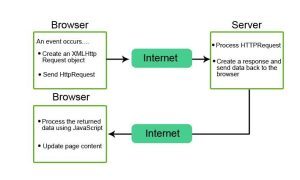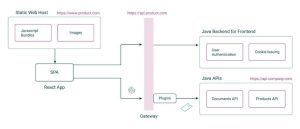
In the domain of web development, Java has often been used in the back end and has offered practical tips for robust development. But the landscape is changing! In this article, we will bust some misconceptions about Java’s ecosystem and show its prominence and prospects in front-end web development.
The Evolution of Java in Front-End Development
For long Java was the go-to language for server-side development due to its reliability and the prospects of handling large complex applications. Java has however made its contribution in front-end development as well (despite common misconceptions), offering valuable tips and techniques for developers (although this is often overlooked by its prominence in back-end development). The release of JavaFX was a big step in this direction. JavaFX is a front end toolkit that allows developers to build rich interactive user interfaces. Before JavaFX, misconceptions about the limited prospects of Java’s front-end capabilities were prevalent. With existing mainstream web-applications handling several hundred thousands of users, performance is often a concern. Java has handled this concern in front-end web development with its large suite of front end frameworks and its compatibility with WebAssembly (Wasm) that lets Java’s ecosystem run within web browsers at light speed.
Overcoming the Misconceptions About Java in Front-End
Due to its old beliefs, Java’s capabilities in front end development often stems from misconceptions. Java is also thought of as being too slow (at least for the quick nature of web interfaces). However, the prospects of faster and more efficient Java have been changing this perspective. Java has only been getting faster and more efficient with improvements in Java Virtual Machine (JVM) and lighter frameworks, enhancing its prospects in modern web development. Another common misconception easily addressed with the right tips are prospects that Java is simply unable to present a responsive web design. However, with frameworks like Java Server Faces (JSF) and Jakarta Faces, Java can easily adapt to different screen sizes. Moreover, tools like Nashron and GraalVM have successfully bridged the gap between Java and JavaScript.
Java Server Faces (JSF) and Jakarta Faces: Reviving Java’s Front-End Capabilities
Java Server Faces (JSF) is a Model-View-Controller (MVC) framework which eases the development process of user interfaces for server-based web applications. The prospects of the frameworks’ component-based approach means developers can build complex high-quality web interfaces without much hassle. Jakarta Faces (from Eclipse Foundation’s Jakarta EE) is yet another framework that further builds upon JSF framework to deliver a more flexible, advanced, and responsive framework that meets today’s user experience standards. The merits of these frameworks lie in the way they incorporate backend systems. Features like AJAX which update parts of webpage without reloading the whole page make for smoother and more interactive user experience (something successful front end systems often possess). The concept of Facelets allows developers to reuse templates and keep layouts and logic nicely separated.
Leveraging Java’s Ecosystem for Enhanced Web Development
Java’s ecosystem consists of several libraries, tools, and tips from a community of skilled developers and years of development. Mixing JSF and Jakarta Faces frameworks with other technologies (like Java EE and Spring Framework) isn’t only practical but also makes for a powerful development platform. Developers get to incorporate Java’s ecosystem of security and transaction management into front end development, making both – the front end and back end communicate with each other smoothly (much handy for big applications). Contrary to misconceptions, all this makes for a safer and more straightforward development process (say goodbye to cross-site scripting and SQL injection).

Figure 1: Illustration of AJAX requests being processed by Java server to perform seamless page updates
Integrating Java with Modern Web Technologies
Java’s ecosystem works well with modern web technologies like JavaScript frameworks, RESTful APIs, and WebSockets, which makes it a great choice for building complex web applications. JavaScript frameworks like React improve application functionality and user experience. With its compatibility with HTML5, CSS3, and JavaScript, Java’s ecosystem fits right into development of interactive web applications (despite the misconceptions). Frameworks like Spring Boot make it easier to communicate with the front end. Java is also great for setting up web services and APIs (perfect for making microservices!) for which Spring Boot framework can once again be leveraged.
Practical Tips for Getting Started with Java in Front-End
-
- TIPS #1 | Start with JavaFX: JavaFX is fundamental in Java front end web development for building interactive user interfaces. Play around with its features like FXML for layouts and Scene Builder for designing. This will equip you with the skill to build attractive and responsive apps.
- TIPS #2 | Explore JSF and Jakarta Faces: JSF and Jakarta Faces frameworks make the majority of Java’s ecosystem in front end development and help you build dynamic and component-based interfaces. Start with their MVC architecture and then explore features like AJAX (to perform partial page refresh) and Facelets to reuse sections of web pages elsewhere.
- TIPS #3 | Use Sprint Boot for Back End–Front End Communication: Spring Boot is a must for linking your front end with the back end. Start by setting up RESTful services using Spring Boot. These services can then be used by Java’s ecosystem of front end frameworks for continuous data exchange (you’ll likely want this when building interactive web applications!).
- TIPS #4 | Take Advantage of Java’s Community: Java’s ecosystem is vast and evolving. Engage with the Java community by exploring forums, social media accounts, and discord servers to keep up with latest tips and practices. Not only will this keep you sharp, but you also get exposed to several collaboration opportunities.
Comparing Java with Other Front-End Technologies
Unlike languages like JavaScript (which are more common in front end development), Java’s ecosystem brings in a secure and powerful application design with type checking, generics, memory management, platform independence, and a mature ecosystem. Compared to languages like Python, Java’s structure helps in managing larger and more complex web applications.
However, Java is often more difficult to learn than HTML/CSS or JavaScript. Creating interactive interfaces is more straightforward using JavaScript frameworks (like React and Angular). These frameworks offer easier ways to update content in real time and connect with different APIs and databases (areas where Java is still catching up). Java’s ability to work well with back end technologies is still an important advantage in successful front end. It bridges the gap between server-side and client-side programming more effectively than its counterparts.
Future Prospects of Java in Web Development
Java’s future prospects in web development is thriving especially with the increasing importance now being paid to fields where strong security features are of necessity—like Internet of Things (IOT) and cloud computing. Being compatible with Android, Java’s ecosystem also makes for a great front end development tool when integrating mobile and web applications (a growing area in web technology). Java’s features make it favorable for large and complex web applications and sees a large adoption in banking and healthcare sector (where security is of utmost importance!). As Java becomes more compatible with newer technologies (like AI and machine learning), it is on a path to transform web development far beyond what is traditionally seen as ‘achievable’.

Figure 2: Illustration of a software architecture design with the use of Java back end for front end to improve web security
Case Studies: Successful Java Front-End Applications
Java’s front end capabilities have been demonstrated in several successful projects. These case studies further ensure Java’s scalability and practicality in real-world applications.
-
- Napoli Gang Project: Ideamotive’s project for Napoli Gang (a European restaurant chain) is a classic example. The chain developed a successful mobile solution that is robust enough to handle a user base of 10,000 customers. The project demonstrated Java’s ability in front end development to tackle high traffic in consumer facing applications.
- JRPass: JRPass is a Japanese railway network’s booking system for which Ideamotive successfully built Java web applications to enhance existing user interfaces and improve business operations. Java’s ecosystem proved to effectively result in an increase in web traffic, optimized transactional costs, and increased sales.
- CustomEase: This case involved developing a cloud-based application for an interior design company that has completed over 10,000 cabinetry projects. The project integrated custom CRM, CMS, ERP, and team communication features with success. This project exhibited Java’s flexibility in creating complex systems that automated day-to-day operations.
FAQs
How has Java evolved for use in front-end web development?
Java has recently made a leap in front end web development mostly thanks to JavaFX—a toolkit that lets developers build responsive and interactive user interfaces. Before JavaFX and compatibility with Wasm, Java couldn’t have achieved much of what it is today capable of (but with the right tips, it is a different story). Java has also gotten quicker and more efficient with improvements in Java Virtual Machine (JVM) and newer lighter frameworks.
What are Java Server Faces (JSF) and Jakarta Faces, and how do they contribute to Java’s front-end capabilities?
Java Server Faces (JSF) and Jakarta Faces are frameworks important in building Java web pages. JSF uses a component-based approach which means you can develop complex web pages for server-based applications more easily. Jakarta Faces takes JSF a step further by delivering a more flexible and modern framework that is at par with today’s web development. Features like AJAX let JSF and Jakarta Faces update sections of a webpage without reloading the whole page, and Facelets allow reusing sections of web page in other web pages. This makes Java a lot more powerful for web development.
How can Java be integrated with modern web technologies for front-end development?
Java works with JavaScript frameworks, RESTful APIs and Websockets. This means Java can be used alongside popular web development tools, incorporating several tips and best practices. Java’s Spring Boot framework for example makes it easy for the front end and back end to communicate. Java fits in with HTML5, CSS3, and JavaScript (the three predominantly used front end languages). All this makes Java a great choice for setting up web services and APIs (especially when building microservices).
